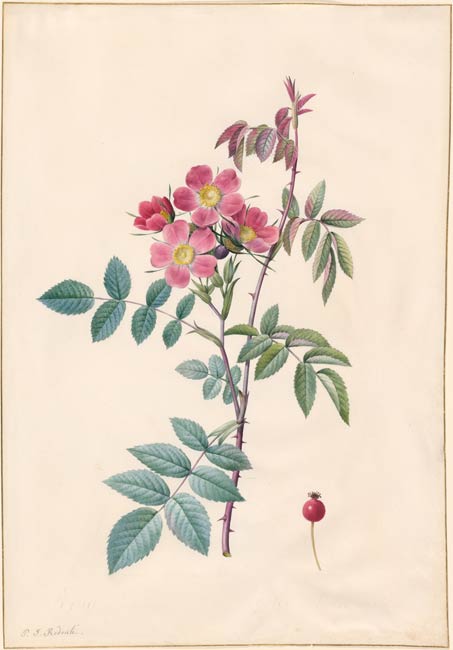
Pierre Joseph Redouté was renowned for his botanical illustrations, which earned him the nickname the “Raphel of flowers.” He was the official painter to Marie Antoinette but deftly transitioned from his employment at the royal court to working for the French Republic with the onset of the Revolution. For navigating such challenges, Redoute was indebted to the patronage of Josephine Bonaparte, who commissioned him to produce the publications Les Liliacées (Lillies, 1802-16) and Les Roses (Roses, 1817-24).
This sheet is a preparatory study for a plate in Les Roses, a compendium of 170 hand-colored engravings reproducing Redouté's celebrated drawings of roses, published in three volumes between 1817 and 1824. Many of the specimens depicted by Redouté are from Josephine Bonaparte's gardens at the grand estate of Malmaison in France, although she died before Redouté completed the work. After the fall of Napoleon in 1815, Redouté returned to work as a court painter under the restored Bourbon monarchy.
Each plate in Les Roses was accompanied by a short text devoted to the plant. Describing the Rosa rubrifolia (Les Roses, Vol. I, opp. p. 32), Redouté highlighted the different attributes of the flower, such as its lack of thorns and need for high sun exposure. He also explained that the rosebush was brought to his attention by the botanist Christian Gottfried Nestler (1778-1832), who found it growing wild in the Vosges Mountains in eastern France.
In 1828, King Charles X purchased the original set of watercolors from Redouté on behalf of his daughter-in-law, the Duchesse de Berry (Maria Carolina Ferdinanda Luise; 1798-1870). De Berry took great interest in botanical illustrations and at one point received drawing lessons from Redouté. She prized the Redoute's watercolors and had the sheets preserved in armorial morocco portfolios. A group of these portfolios was acquired by de Berry's half-sister, Princess Teresa Cristina de Bourbon, Empress of Brazil (1822-1889), and was likely inherited by her daughter Isabel, Princess Imperial of Brazil (1846-1921). The royal family was exiled to Portugal following a military coup in 1889 and it is believed the portfolios of drawings remained with them. After her mother's death, Isabel moved her family to France in 1890. The portfolios were then likely inherited by her son, Prince Pedro de Alcântara of Orléans-Braganza (1875-1940) and some were sold individually after his death. The Morgan owns this and one other sheet (inv. 1957.7) from the original set. Two further sheets are in the Hunt Institute for Botanical Documentation at Carnegie Mellon University (inv. 0040, 0043), and several were sold at Sotheby's in 1948 and 2010 from the Hesketh family.
Signed at lower left, in gold, "P. J. Redouté".
Louis XVIII, King of France, 1755-1824, former owner.
Berry, Marie-Caroline de Bourbon-Sicile, duchesse de, 1798-1870, former owner.
Orleans-Braganza family, former owner.
Bechtel, Edwin DeTurck, 1880-1957, former owner.
Adams, Frederick B., Jr. Fifth Annual Report to the Fellows of the Pierpont Morgan Library. New York : Pierpont Morgan Library, 1954, p. 77.
Pierpont Morgan Library. Review of Acquisitions, 1949-1968. New York : Pierpont Morgan Library, 1969, p. 162.
Flowers in Books and Drawings ca. 940-1840, Helen B. Mules, Dr. Paul Needham, William M. Voelkle, The Pierpont Morgan Library, New York, 1980, no. 129, pl. 23.
